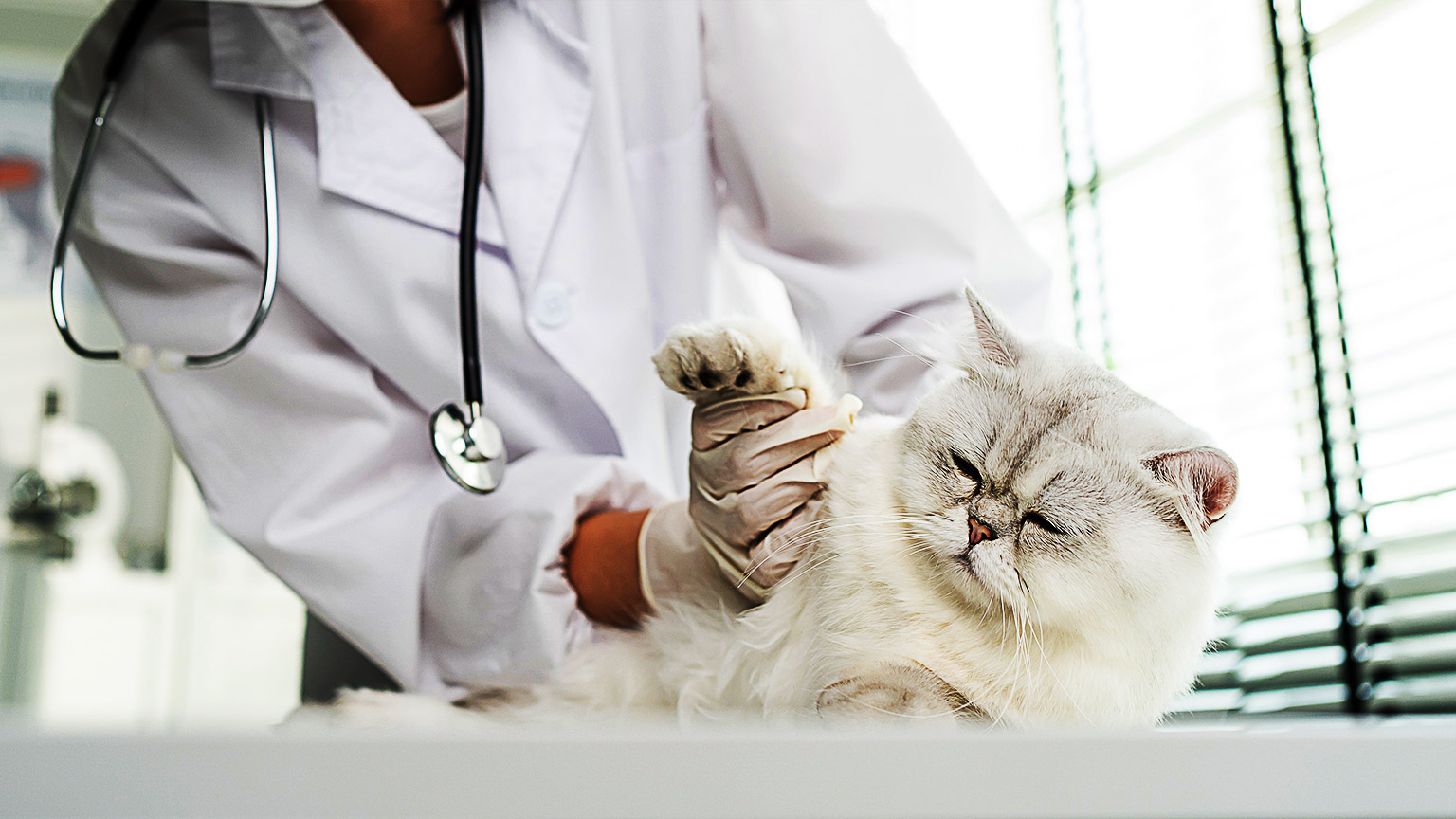There will be many types of animals that you will work with over time, and it is important you learn the general nature of these animals to observe how to manage them when they are ill.
One of the key indicators something is wrong with a companion animal is changes in their behaviour. There are specific behavioural signs to be mindful of including any of the following:
- Body language
- Depicting different emotions including:
- distressed
- aggressive
- relaxed.
Once you become familiar with the signs of behaviour, you will also need to consider the following:
- Observe animal behaviour before approaching or handling to check for risks to safety of self, and other people or animals.
- Use appropriate techniques, equipment, and PPE to safely handle and control the companion animal to avoid being bitten or scratched.
- Handle animals calmly and safely according to workplace guidelines and animal welfare principles.
Let’s take a look at these in further detail.
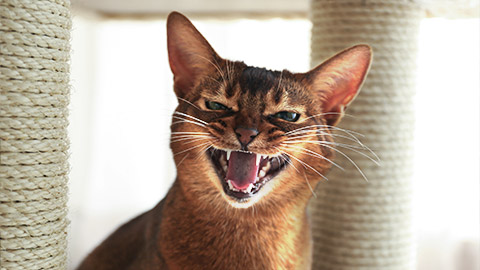
Companion animals are generally friendly and appear happy in nature and are responsive to humans. They are likely to exhibit excitement or contentment through the way they respond to humans or other animals.
Excited or happy behaviour indicators may include:
- jumping
- barking
- licking
- tail wagging.
Relaxed behavioural indicators may include:
- purring
- docile
- calm.
It is when this behaviour changes that generally indicates there is something not quite right and the animal may be sick, injured, frightened or in pain.
The following behaviours that indicate the animal is aggressive or frightened:
- Aggressive behaviour indicators
- lunging
- snarling
- biting
- scratching
- hissing
- barking.
- Frightened behavioural indicators
- hiding
- trembling
- jumping on the owner
- attempting to escape.
Some animals may be fine outside the cage but can turn aggressive once placed inside a cage.
Behaviour should always be noted on the animal’s file as well as on the history for the visit on the day.
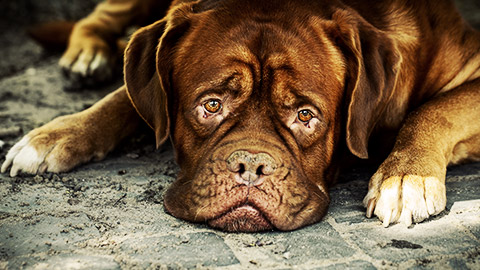
Sometimes, there are visible physical features that an animal may exhibit which indicates they are in pain or sick. It is important you are aware of the animals’ history because they may have an existing condition effecting their physical abilities.
Some of the physical indicators an animal may present when they are injured or unwell may include:
- injury or pain
- broken bones
- cuts
- abrasions
- limping or lameness
- excessive panting
- lack of appetite
- self-trauma
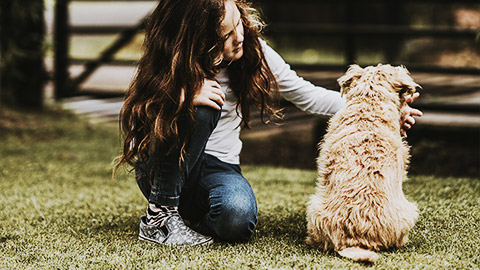
In any circumstance, you need to be mindful of how you approach an animal. This is even more important when they are unwell. Before you attempt to handle, you must observe their behaviour. You will need to look for how they approach you at the gate or cage where they are being held. If the animal is exhibiting aggressive behaviour, you should avoid attempting to handle it until it has calmed down. If you try to handle the animal without observing the behaviour first, you risk the animal lashing out and biting or scratching you. The danger of bites or scratches is heightened as soon as the animal has been diagnosed with an infectious disease.
If you are ever unsure of how you should approach an animal in under these circumstances, you should always ask for support or assistance from the veterinarian or an experienced member of the team. It would also be of benefit to observe how other experienced people approach animals. Never attempt to approach or handle the animal if you are feeling unsure, this is when accidents are likely to happen.
Case Study
Zoe’s new client Loki

Zoe is meeting a new dog walking client today – a German Shepherd named Loki. They aren’t going to walk together just yet and the purpose of the meeting is for Zoe and Loki to be introduced to each other.
Loki is young but is already very large and strong. His owner Anu has advised Zoe that Loki has the usual German Shepherd temperament: reserved and protective of his family and territory but not overly aggressive. Loki has been a star pupil at his doggy training school, so Anu is confident that while she is away at work, Zoe will be able to manage Loki and take him for a daily walk.
When Zoe arrives at Anu’s house, Anu has him on his lead and he is sitting. He stands up quickly when Zoe walks through the door. Zoe has heaps of experience with dogs and approaches Loki quietly and calmly, allows him to smell her hand first and then the rest of her body. She keeps her body to the side and does not make eye-contact. Once Loki shows positive body language she gently pats him. Loki is excited to meet a new human and jumps up against her, but she firmly pushes him away. So far their first meeting is going really well.
Tip
If you are attempting to approach a dog, you should approach quietly and calmly, allow animals to smell you and crouch down to their level. You should also turn your body to the side.
If you are approaching a cat, Feliway is recommended to use because it acts as a calming agent for the cat to help keep them calm. It can be sprayed either on the blankets, or into the cage.
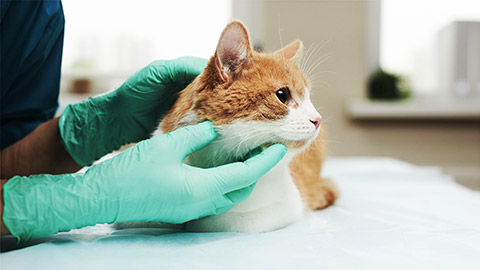
Once you have observed and approached the animal, you will need to handle it. When you are handling the animal, you will need to use the appropriate techniques, equipment, and PPE to safely handle and control the companion animal to avoid being bitten or scratched.
It is important that you handle animals safely, in accordance with workplace health and safety in a compassionate and caring manner.
Offering Comfort
Providing comfort and support is a sign of compassion. Most companion animals are affectionate in nature and generally respond to physical comfort from the handler.
Types of comfort and compassion you could provide to an animal may include:
- holding the patient in a nonthreatening and safe way
- speaking calmly and softly (do not yell or raise your voice)
- providing soft comfortable bedding and warmth
- provide a safe hiding place for cats in their cage or enclosure and blankets with Feliway.
While demonstrating compassion and affection to animals, you need to be mindful there are several hazards and risks that come with it. The following table illustrates both animal and non-animal related safety hazards:
| Animal | Non-Animal |
|---|---|
| Bites | biological hazardous waste |
| Scratches | Explosions |
| Kicks | manual handling lifting, carrying, moving of heavy boxes or objects |
| crush injuries | sharps injuries (needle pricks, cuts) |
| Zoonoses | chemicals and medicines |
| manual handling lifting, carrying, moving animals | gas leaks |
| release of infectious agents | slip hazards |
| reinfection of contagious agents to both human and animal |
When clients and their pets come into your workplace there will be time that you will have to assist with restraining and handling animals. It is important to remember that:
- the owners will be watching you to learn how to properly handle animals.
- being professional means being safe and humane.
- good animal handling skills prevent staff from being injured.
- good animal handling skills reduce stress for the animal.
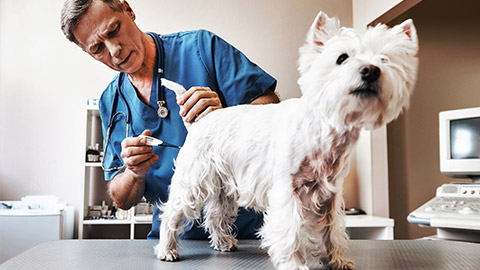
When you are attempting to handle an animal, you will need to be mindful of the stress for animals in the workplace setting. Workplaces can be extremely chaotic for any animal: the incredible number of smells, other stimuli means that animals are likely to be confused, overwhelmed, and distressed. You must also consider animals that may never have been handled or examined before. They may not have any experience on a leash and may panic in response. Even the most social animal may exhibit aggression toward other animals, particularly in a strange environment and may also redirect to nearby people when over-stimulated.
The following list provides you with some general safety considerations for safe handling:
- Never put your face directly into the face of a dog or cat or other companion animal.
- Do not move in behind or crowd around a dog.
- Concentrate on the animal you are handling without being distracted by other activities.
- Never sit on the floor while handling/examining a dog. If the animal becomes aggressive or aroused, you will be unable to move away or protect yourself and risk serious facial bites.
- Always be prepared to protect yourself or move away quickly in the event an animal becomes aggressive unexpectedly.
Safe and effective animal handling requires a thorough understanding of the normal behaviour and responses of each species. If there is any doubt about the temperament of an animal, you should always ask for assistance before attempting to move the animal. Remember, there is no substitute for observance care and experience.
Equipment and Personal Protective Equipment (PPE)
You also need to be aware of the need for specific types of equipment and PPE. Animals should never be moved unless you are organised and prepared to do so. You should ensure you have ready any of the following equipment ready:
- leash
- harness
- blankets
- Feliway (for cats)
- treats
- sedatives if necessary
In conjunction with the equipment, you must ensure you have elected a pathway or route you are going to take to move the animal. You will need to be considerate of doors and gates, make sure they are closed behind you in case the animal tries to run. You must also be mindful of other animals in the area, especially if the animal you are moving is suspected to have an infectious disease or does not respond well to others. Movement should be limited and if it is necessary the route you take should have as minimal traffic as possible.
PPE must also be considered when you are attempting to move an animal with a history of aggression or a suspected (or diagnosed) infectious disease. You want to minimise the risk of being bitten or scratched as well as ensuring others around you are also safe.
The PPE you will need to consider may include:
| TYPE OF PPE | PURPOSE |
|---|---|
| Animal Handling Gloves | Offer protection from bites or scratches, they are generally puncture proof and will cover your hand up to the mid forearm |
| Disposable gowns | Offer protection for yourself and clothing from bodily fluids and discharge |
| Face masks/ shields | Offer protection from inhalation of animal secretion or chemical agents |
Let’s take a look at the methods that can be applied when capturing and restraining animals.
When it comes to capturing and restraining animals, you need to consider the technique you are using and the species of animal you are applying it to. First, what is the difference between capturing and restraining?
Capturing involves catching the animal either with a leash or by hand. Whereas restraining is restricting the movement of the animal so it can be examined. There are human and inhumane methods of both capture and restraint of animals, and in any circumstances, you must always opt for the safest and most humane approach.
Not all restraining techniques are the same and they will need to be altered to suit the type of animal you are working with. Some capturing and restraining techniques may be similar, depending on the animal and some may be different entirely. In addition to this, you will also need to be mindful the technique you apply is safe and humane. You do not want to restrain an animal that will cause them unnecessary pain, fear or present a hazard to you or the animal. Remember, if you are not completely certain, always ask for help.
Assessment tip
Animal handling will be part of the practical requirements for the assessment for this module. Once you have studied the information in this part of the learning content you should talk to your supervisor to arrange some practice sessions where you can get feedback from them. This will ensure that when you do your assessment you will be confident with your handling techniques. Your assessment event should not be the first time you handle an animal.
Dogs
When it comes to capturing dogs, you need to be mindful of the nature of the dog, the area you are in and what condition the dog is in, whether it is sick or in pain. Remember, the nature of an animal can change suddenly when they are in pain or sick.
Capture
When you are attempting to capture a dog, you should consider the following:
- Call the patient by their name and approach in a non-threatening way from a distance so the dog can see you. You may want to use a treat to help entice the dog.
- Using a leash to loop around the patient’s neck, it is important you do not attach a lead to the patient’s collar as most owners make the collar too loose and the patient will be able to slip out.
- Ask the owner to place a muzzle and lead to the patient then take the lead from the owner gaining control of the patient
- Place a large towel or blanket over the top of the patient then you can pick the patient up making sure your hands are not near the mouth allowing the dog to bite you.
- Pet carriers (some patients will willingly go into a carrier and others will need some encouragement)
- Muzzle the patient with the appropriately sized muzzle (even the friendliest of dogs can bite when in pain)
- Dog poles for aggressive patients
- Chemical restraint (Sedatives) in the most extreme of circumstances.
Restraints
When a dog needs restraining, there are two popular methods of restraint: lying down and a head lock. Keep in mind, depending on the nature and response of the dog, you may require a muzzle prior to attempting to restrain it.
LYING DOWN RESTRAINT METHOD:
- Start by standing alongside the dog. Make sure that the front of your body is along the side of the dog
- Coming from over the top of the dog, hold the front and hind leg that is closest to you
- Ask someone to hold and guide the dog’s head as you gently pull the dog’s legs out from under them. At this point, there may be some struggling so be prepared
- Once the dog is down DO NOT let go of the legs otherwise, the dog will be able to stand again
- Using your elbow at the front of the dog gently apply pressure to the dog's neck. This will prevent the dog from being able to lift its head allowing you to have control.
Fun fact!
You can also use this restraint for cats.

The following image sliders provide you with a visual representation of these restraining techniques.
- Standing beside the dog facing the dog’s body, place your forearm around the dog’s neck and hold snug holding the head still (head lock formation)
- Place your other arm under the dog's belly close to the hips. Hold this position firmly
- Some dogs may find it difficult to stand like this so they can lie down. When the dog is lying down, place your other hand (that would have been under the dog) around the dog’s body holding the body firmly into your body.
Cats
When capturing and restraining cats, there are similar techniques or strategies you can apply to help with cats that you may have used for a dog. Remember, when you are dealing with cats, they have very sharp retractable claws, you may need to consider using durable gloves during this process as an added layer of protection. If you are using towels and blankets, you should ensure they are sprayed with Feliway to help keep the cat calm.
Capture
When you are attempting to capture a cat, you should consider the following:
- Call the patient by their name and reach into the cage with your hand in a non-threatening way, you may want to use a treat to help entice the cat.
- Open and remove the top of the cat’s cage and lift the cat out.
- Picking the cat up from examination table and restraining them in your arms
- Place a large towel or blanket with Feliway over the top of the patient, wrap the patient up in the towel, then you can pick the patient up making sure your hands are not near the mouth allowing the cat to bite you
- Pet carriers (some patients will willingly go into a carrier and others will need some encouragement)
- Muzzle the patient with the appropriately sized muzzle (even the friendliest of cats can bite when in pain)
- Cat crush cages (a cage with a moveable side panel to hold the cat securely against the cage walls)
- Cat trap
- Anaesthetic chamber when extremely aggressive
- Scruffing the cats neck fur (mother cat hold)
- Chemical restraint (sedatives) in the most extreme of circumstances.
- Cat bag
Restraint
There are a number of different ways to restrain cats. Here are some examples of cat restraints.
CAT BAG RESTRAINT:
- Place cat’s head into the opening at the top of the bag
- Tighten the neck opening so the cat cannot get it’s front foot out
- Either hold the cat off the table and zip the bottom up or turn the cat onto it’s back to zip the bottom up
- Be careful of the cat’s fur and tail when zipping the bag up
- The bag can then be unzipped slightly to allow hind leg to be exposed
HEAD RAISING RESTRAINT:
- Hold the cat's front legs with one hand
- With the other hand hold the cat’s head and raise it to the roof stretching the cat neck out
- You can also stretch the cat over the examination table to allow for extra stretching.
The following image sliders provide a visual representation of each of these restraining techniques.
Rabbits
Rabbits are quite fragile and quick animals that often scare easily. You will need to ensure you are careful and apply the correct capture and restraining techniques to avoid causing unnecessary stress and harm to the animal when you are capturing and restraining. Rabbits will kick out hindlegs. On slippery surfaces this can cause serious injury, such as broken bones in their back.
Capture
- Pet carriers (some patients will willingly go into a carrier and others will need some encouragement)
- Picking the rabbit up from examination table and restraining them in your arms
- Place a towel or blanket over the top of the patient, wrap the patient up in the towel, then you can pick the patient up
- Hutch or trap
- Anaesthetic chambers when extremely aggressive
- Chemical restraint (sedatives).
Restraint
Rabbits need to be restrained properly as they can easily injure themselves: with incorrect restraint for example, they can break their back. There are two common restraint techniques, these include underarm carrying and towel wrapping.
UNDERARM CARRYING:
- Tuck the rabbit’s head under your elbow and put the hand of that same hand under the rabbit’s stomach
- With the other hand scoop the rabbit’s backside up as you lift the rabbit off the table.
TOWEL WRAPPING:
- Place the towel on the examination table
- Pick up the rabbit ensuring that you are supporting its back at all times and place rabbit onto towel
- Wrap the towel under the neck and around the body of the rabbit leaving only the head and ears out.
The following image sliders provide a visual representation of each of these restraining techniques.
Rodents (Rats and Mice)
Rats and mice may be quite comfortable with being handled by humans and due to their curious natures may willingly climb onto a human hand. However, being in an unfamiliar environment can mean that they suffer stress and anxiety just as other companion animals do. Never handle a rat or a mouse by their tail as this can cause them extreme anxiety. In the wild a rat or a mouse captured by the tail by a predator may shed their tail as a survival tactic. While this is a natural phenomenon and does not necessarily cause the animal harm, the tail will not grow back once this has occurred. When handling companion rats and mice we need to make sure that we do so in a way that ensures stress and anxiety is kept to a minimum.
Both rats and mice will bite to defend themselves, but rats have a very strong bite and should be handled with caution.
Capture
- Allow confident and secure animals the opportunity to voluntarily move onto your hand
- Cupping – scoop the mouse or rat into your hand (https://vimeo.com/236715432)
- Use a handling tunnel (https://vimeo.com/236716093)
Restraint
Use the scruffing technique. In the video below the mouse is picked up briefly by the base of the tail and then placed on top of the cage. This allows the mouse to grip the wires securely as you grasp the loose skin at the back of its neck. The mouse is unable to move in this position but is held safely and securely.
Watch: Basic Mouse Restraint (0:22 minutes)
Rats can be restrained by grasping them around the shoulders and supporting them from beneath using your free hand.
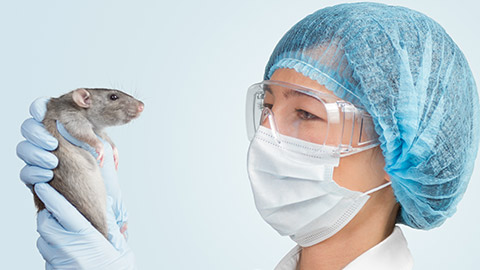
Birds
Many of the common companion birds can be trained to hop on to a human finger or arm. Like the 4-footed companion animals we have already discussed, you may be working with a bird who is in an unfamiliar or stressful situation. In this case, it may not willingly climb onto your offered hand and may bite to defend itself. Birds have fragile bones (to make flight possible) so must be handled very gently.
Capture
For small birds:

For medium birds:
- Use both hands to hold the bird’s wings securely closed. Your thumbs will rest gently on the bird’s back. Extend both pinky fingers for the bird to grip with its claws.

For all companion birds:
- Use a fine net, a towel or a blanket to drape over the bird and then pick it up, still wrapped, using one of the techniques above. You should make sure the bird’s head is free so it can breathe once you have securely picked it up.
Larger, stronger birds such as parrots may require you to wear gloves for protection when picking them up.
Activity
Every animal care organisation will have a different procedure or method for the capture of animals. You must ensure that you follow the policies and procedures set out by your organisation before you partake in any capturing of an animal. You should also seek advice from your supervisor or manager to confirm the procedure.
- Check your organisation’s policies and procedures on handling companion animals and familiarise yourself with anything that is not covered by this topic.
- Speak to your supervisor about your assessment and ask for some training on handling different types of companion animals so that you get some feedback as you practice.
Activity
Let’s recap what we have covered in this section.
We will revisit handling animals in Topic 4 in more depth than we have just covered, as this is a really important part of the learning for this module. Now that we have covered general animal behaviours, let’s go over what unusual behaviour looks like, jump on into Topic 3.
